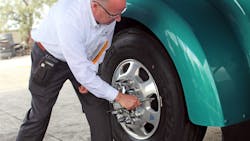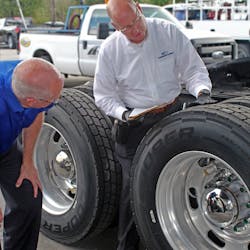Proper inflation is key to a good tread footprint with even wear—which translates to more miles to removal.
First, determine the tire’s optimum inflation pressure using a scale weight by axle and then reference a load/inflation table.
With an 80,000-pound gross vehicle weight, the load/inflation is relatively easy. The typical steer axle is at 12,000 pounds, or 6,000 pounds per tire. In a 295/75R22.5 tire size, 110 psi cold results in 6,175 pounds in capacity. On the duals at 17,000 pounds per axle, or 4,250 pounds per tire with the same size 295/75R22.5 tire, the inflation figure at 85 psi carries 4,690 pounds per tire.
This is not the old “100 psi works for all scenarios.” A more accurate measure leads to better wear, longer tire life, and fewer impact breaks with a lower inflation figure. Over inflation increases the opportunity for punctures and impact breaks. Plus it can cause irregular wear, improper handling, ride disturbances, and reduced inflation. That’s why a load/inflation chart is a good thing to get friendly with. It will pay dividends.
Here’s one example of why it’s so important: Mismatched inflation on dual assemblies can be an important contributor to faster tire wear. In an 11R22.5 tire size mounted in a dual assembly with the same tread design, a tire with 5 psi difference in inflation would mean the lowest inflated tire has a circumference that is 5/16-inches smaller. During every rotation cycle, the smaller circumference tire must scuff ahead to keep up with the tire with more inflation. These tires rotate around 500 times per mile. Simple math means 500 times 5/16-inches translates to 156.3-inches per mile, or 13 feet per mile. Imagine dragging a tire 13 feet every mile. How many feet is that per day or per year? That illustrates clearly why fleets will see increased tire wear with improper pressure.
Another note on inflation for those running automatic inflation systems: How often are fleets checking the inflation and correcting the pressure on these mismatched dual assemblies? Don’t automatically assume they’re properly inflated. It is critical to check them on a scheduled basis.
One last tip to longer life is to stay on top of tire rotations, especially when seeing signs of irregular tread wear. Tire rotations may help to reduce wear. One of the potential benefits of a change in the direction of the rotation, or when cross rotating the tires, is the evening out of the irregular wear areas. Tire rotations can even out some heel/toe wear on the shoulders of drive tires and erratic wear on the shoulders of trailer tires. Steer tires normally are rotated side-to-side, which again changes the direction of rotation and can help even out wear. If there is a 3/32-inch to 4/32-inch difference in tread depth between the drive axles, a cross rotation may be recommended to even out the wear and increase tire life before removal.
Jason Miller is Cooper Tire’s National Fleet Channel Sales Manager.
About the Author
Jason Miller
Jason C. Miller is Cooper Tire’s national fleet channel sales manager. He has worked in all aspects of the tire industry, mastering complex tire programs for some of the largest fleets in North America. A member of the American Trucking Association’s Technology and Maintenance Council (TMC), Jason is also a TIA certified tire instructor and former ASE certified technician. He has a Bachelor of Science degree in information technology and a Master of Science degree in integrated marketing communications from Northwestern University.

